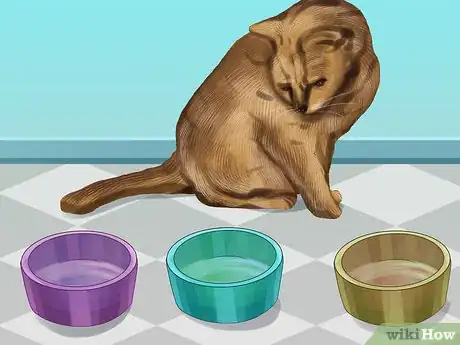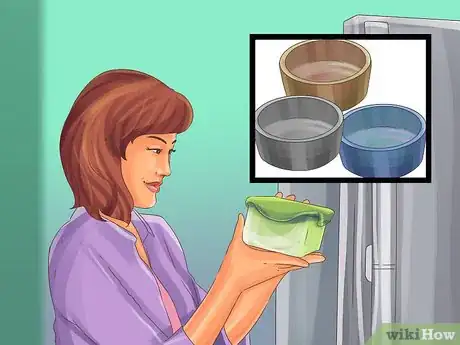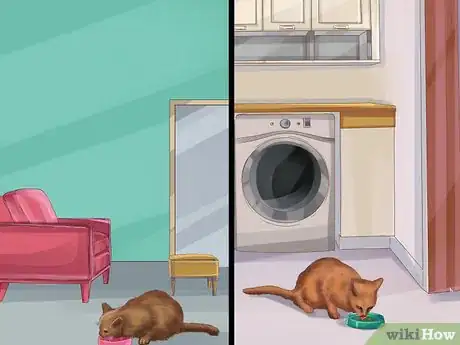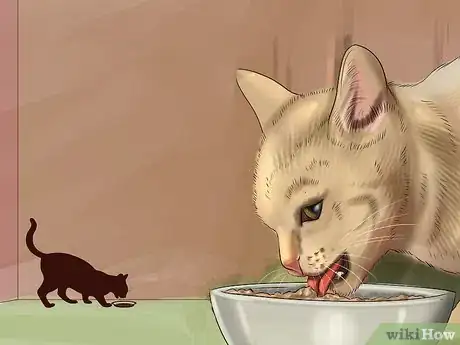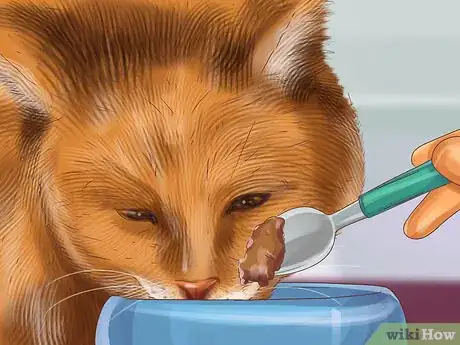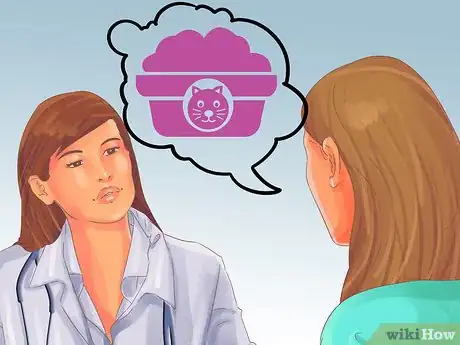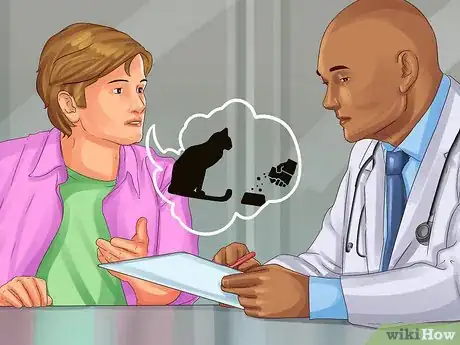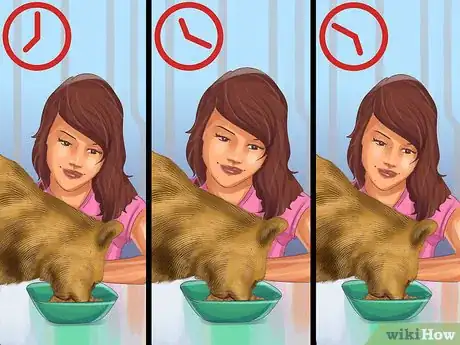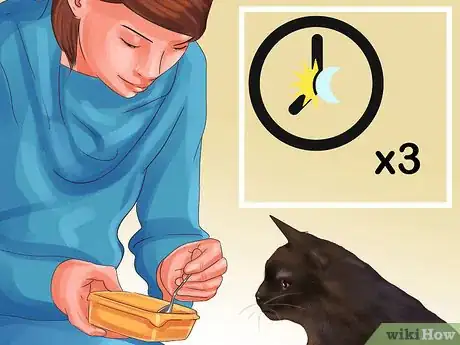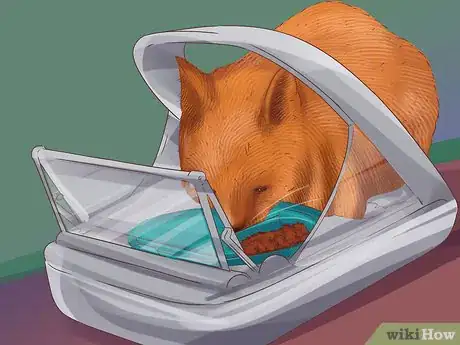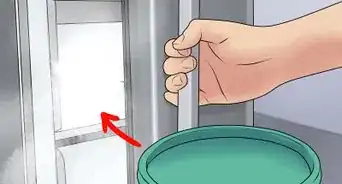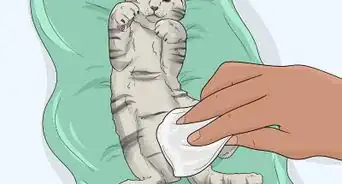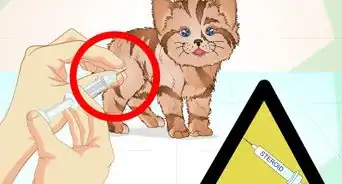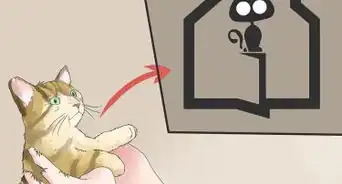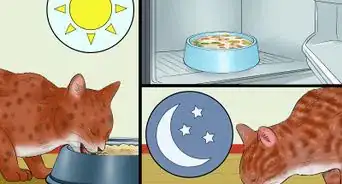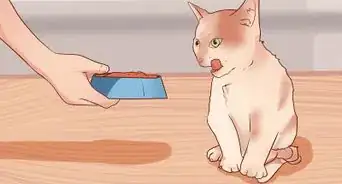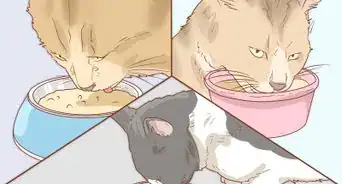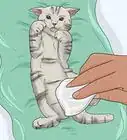This article was co-authored by Pippa Elliott, MRCVS. Dr. Elliott, BVMS, MRCVS is a veterinarian with over 30 years of experience in veterinary surgery and companion animal practice. She graduated from the University of Glasgow in 1987 with a degree in veterinary medicine and surgery. She has worked at the same animal clinic in her hometown for over 20 years.
There are 7 references cited in this article, which can be found at the bottom of the page.
This article has been viewed 15,544 times.
As the saying goes, herding cats is no easy task. However, feeding multiple cats different diets doesn’t have to be stressful. Provide individual bowls and color code them to help yourself stay organized. Start by feeding your cats in shifts or in separate rooms. Get your cats used to new diets gradually to avoid digestive problems and food aversion. For best results, switch from free-feeding to scheduled meals. Over the course of a week, work your way down until you feed your cats two or three meals at the same times every day.
Steps
Setting Up Feeding Stations
-
1Get different colored bowls for each cat. If you’re used to free-feeding your cats out of one large bowl, you’ll need to transition to scheduled feedings and use individual bowls. Your cats won’t care about the color coded bowls, but they’ll help you keep track of which kind of food to feed each cat.[1]
- Make sure each cat also has its own water bowl, especially if you’re feeding them in separate rooms.
- You can also write a cat’s name on each bowl in permanent marker.
-
2Keep a list handy of which food to place in each bowl. If you feed your cats in the kitchen, keep a list with feeding information on the refrigerator. Write each cat’s name, its food variety, and its bowl’s color if you’re using a color coded system.[2]
- Matching the right food with each cat will probably become second nature, but you should take your time and develop a system to avoid confusion. Mix-ups can be dangerous, especially if one cat has a prescription or therapeutic diet.
Advertisement -
3Feed your cats in different spaces at first. It’s best to feed your cats in shifts when you start getting them used to individualized diets. Keep all but one of your cats out of the feeding room, then set out the appropriate food for one cat. Give it 20 minutes to eat, then when it’s done, move on to the next cats one at a time.[3]
- You can also keep your cats in separate rooms with closed doors and feed them at the same time.
-
4Set bowls out at different ends of a room. As your cats get used to their individual diets, you can try feeding them in the same room at the same time. Fill each bowl with the appropriate food and set them in opposite sides of the room.[4]
- The farther apart you set the bowls, the more comfortable your cats will be, since cats like some privacy during mealtime. You’ll also have an easier time keeping one cat from getting into another’s food.
-
5Monitor your cats while they eat. Keep an eye on your cats while they eat, especially if you feed them in the same room at the same time. You’ll need to make sure none of them try to get into another’s food. It’s also important to make sure they’re not refusing to eat.[5]
- Contact the vet if any of your cats refuses to eat or experiences vomiting or diarrhea in reaction to its new diet.
Getting Your Cats Used to New Diets
-
1Change your cat’s diet when it’s in good health. If one of your cats has recently been ill or hospitalized, avoid changing its diet unless the vet tells you it’s necessary. Waiting until it’s recovered before switching its food will prevent food aversion and make the transition easier.[6]
- If you suddenly start feeding a cat new food while it’s sick, it will likely associate the new food with being sick, and it’ll resist its new diet in the future.
-
2Transition to a new diet slowly. Switching to a new diet abruptly can cause digestive problems, particularly when changing from dry to wet food. Start by feeding your cats their new food at one meal per day and the old food at other daily meals. Gradually work towards feeding them new food at all meals over the course of four to seven days.[7]
- You can also try mixing the old and new food together. Feed your cat 75 percent old food and 25 percent new on the first day, 50 percent of each on the next day, 25 percent old food on the third, and only new food on the fourth.
-
3Try putting a small amount of the old food on top of the new food. If you have trouble systematically switching your cat’s meals, you can mix old and new food together. Try placing a small amount of the old food on top of the new food. Gradually decrease the amount of the old food you include with each meal until you can omit it completely.[8]
-
4Ask your cat’s vet if it’s okay to add something extra tasty to new food. If you have any problems getting your cat used to its new diet, you can try adding a tasty, high-value flavor to its new food. Pour in a bit of canned tuna juice or a flavor you’ve observed your cat show preference for in the past.[9]
- Be sure to ask the vet if it’s okay to add anything to your cat’s food. If your cat is obese or on a prescribed or therapeutic diet, an additive might not be the healthiest choice.
-
5Consult the vet if you need to switch a cat’s diet quickly. If you do need to switch your cat’s diet abruptly, you should do so with the vet’s guidance. The vet might find it prudent to keep the cat in their office for two or three days to oversee the diet transition.[10]
- Keeping the cat with the vet or having it hospitalized during a forced switch will help prevent digestive problems or malnourishment.
Switching from Free-Feeding to Scheduled Feeding
-
1Start with more frequent scheduled feedings. If your cats are used to free-feeding, start getting them used to scheduled feedings with four or five daily meals. Divide their daily recommended portion accordingly to avoid overfeeding.[11]
- For example, divide one full day’s food portion by four if you’re feeding it four meals, so each meal consists of one-fourth its daily need.
- The amount of food a cat needs to eat per day depends on its age, size, and overall health. If you haven’t already, work with your cats’ vet to come up with a meal plan appropriate for each cat.
-
2Work gradually toward two to three consistent daily feedings. After two or three days, eliminate one of the scheduled feedings. Be sure to adjust meals’ portion sizes accordingly so your cats get their recommended daily value. Eventually, wean them down to two to three meals per day.[12]
- For best results, schedule mealtimes at consistent times each day.
-
3Consider using an electronic microchip feeder. You might have difficulty keeping consistently scheduled mealtimes for multiple cats due to work or being out of town. There are electronic feeders available that release food at certain times of day or only to a cat with a corresponding microchip.[13]
- You can find an electronic feeder online or at your local pet supply store.
- To use the feeder, each of your cats will have to have an ID microchip installed and yo will need a special feeder that dispenses food based on the cat's ID and what you have programmed in as the cat's diet. Other pets that are not granted access to the food will not be able to access it.[14]
- You could also use the feeder to provide regular food to most of the cats in your household and not program in the cat that needs a special type of food. You would then have to feed that cat manually.
Expert Q&A
-
QuestionCan two cats share a food bowl?
 Pippa Elliott, MRCVSDr. Elliott, BVMS, MRCVS is a veterinarian with over 30 years of experience in veterinary surgery and companion animal practice. She graduated from the University of Glasgow in 1987 with a degree in veterinary medicine and surgery. She has worked at the same animal clinic in her hometown for over 20 years.
Pippa Elliott, MRCVSDr. Elliott, BVMS, MRCVS is a veterinarian with over 30 years of experience in veterinary surgery and companion animal practice. She graduated from the University of Glasgow in 1987 with a degree in veterinary medicine and surgery. She has worked at the same animal clinic in her hometown for over 20 years.
Veterinarian Sharing a food bowl is stressful for cats, though we don't always recognize the signs. It's much better to give each cat their own bowl, preferably on opposite sides of the room. This prevents one cat from dominating the food and making the other cat stressed because they want to eat but feel inhibited.
Sharing a food bowl is stressful for cats, though we don't always recognize the signs. It's much better to give each cat their own bowl, preferably on opposite sides of the room. This prevents one cat from dominating the food and making the other cat stressed because they want to eat but feel inhibited. -
QuestionHow do I get my cat to lose weight with multiple cats?
 Pippa Elliott, MRCVSDr. Elliott, BVMS, MRCVS is a veterinarian with over 30 years of experience in veterinary surgery and companion animal practice. She graduated from the University of Glasgow in 1987 with a degree in veterinary medicine and surgery. She has worked at the same animal clinic in her hometown for over 20 years.
Pippa Elliott, MRCVSDr. Elliott, BVMS, MRCVS is a veterinarian with over 30 years of experience in veterinary surgery and companion animal practice. She graduated from the University of Glasgow in 1987 with a degree in veterinary medicine and surgery. She has worked at the same animal clinic in her hometown for over 20 years.
Veterinarian This is extremely tricky, and success depends on preventing the overweight cat from getting free access to the other cats' food. Microchip activated feeders are one option, where you program in the chip number for the slim cats only. Alternatively, make a feeding station with a narrow entrance that the larger cat isn't physically able to enter.
This is extremely tricky, and success depends on preventing the overweight cat from getting free access to the other cats' food. Microchip activated feeders are one option, where you program in the chip number for the slim cats only. Alternatively, make a feeding station with a narrow entrance that the larger cat isn't physically able to enter. -
QuestionHow much should two cats eat a day?
 Pippa Elliott, MRCVSDr. Elliott, BVMS, MRCVS is a veterinarian with over 30 years of experience in veterinary surgery and companion animal practice. She graduated from the University of Glasgow in 1987 with a degree in veterinary medicine and surgery. She has worked at the same animal clinic in her hometown for over 20 years.
Pippa Elliott, MRCVSDr. Elliott, BVMS, MRCVS is a veterinarian with over 30 years of experience in veterinary surgery and companion animal practice. She graduated from the University of Glasgow in 1987 with a degree in veterinary medicine and surgery. She has worked at the same animal clinic in her hometown for over 20 years.
Veterinarian This will depend on whether they are eating dry food (which is much more calorific) or wet food (which is less calorie dense). Also, each brand has a different calorie content so it's not possible to give general advice. Always check the packaging as this should give a recommended feeding amount, but if in doubt give slightly less than recommended as the manufacturers often over-estimate.
This will depend on whether they are eating dry food (which is much more calorific) or wet food (which is less calorie dense). Also, each brand has a different calorie content so it's not possible to give general advice. Always check the packaging as this should give a recommended feeding amount, but if in doubt give slightly less than recommended as the manufacturers often over-estimate.
References
- ↑ http://www.catbehaviorassociates.com/how-to-feed-different-diets-in-a-multiple-cat-household-eight-quick-tips/
- ↑ http://www.catbehaviorassociates.com/how-to-feed-different-diets-in-a-multiple-cat-household-eight-quick-tips/
- ↑ http://catinfo.org/feline-obesity-an-epidemic-of-fat-cats/
- ↑ http://www.catbehaviorassociates.com/how-to-feed-different-diets-in-a-multiple-cat-household-eight-quick-tips/
- ↑ http://www.catbehaviorassociates.com/how-to-feed-different-diets-in-a-multiple-cat-household-eight-quick-tips/
- ↑ http://www.vetstreet.com/our-pet-experts/need-to-switch-your-pets-food-here-are-key-steps-to-take
- ↑ http://www.vetstreet.com/our-pet-experts/need-to-switch-your-pets-food-here-are-key-steps-to-take
- ↑ http://www.vetstreet.com/dr-marty-becker/how-do-i-get-my-cat-to-eat-new-food?page=2
- ↑ http://www.vetstreet.com/our-pet-experts/need-to-switch-your-pets-food-here-are-key-steps-to-take
- ↑ http://www.vetstreet.com/dr-marty-becker/how-do-i-get-my-cat-to-eat-new-food?page=2
- ↑ http://www.catbehaviorassociates.com/how-to-feed-different-diets-in-a-multiple-cat-household-eight-quick-tips/
- ↑ http://www.vetstreet.com/our-pet-experts/multiple-diets-for-multiple-pets-6-tips-to-make-your-life-easier
- ↑ http://strayhavenrescue.org/feline-nutrition/
- ↑ https://www.surepetcare.com/en-gb/pet-feeder/microchip-pet-feeder
About This Article
To feed different diets to multiple cats, feed them one at a time in a designated room so they become familiar with their specific food. Alternatively, you can keep them in separate rooms with closed doors. Once they’ve gotten used to their specialized diet, you can put their food bowls on opposite sides of the same room. While your cats are eating, watch them to make sure they actually eat and don’t get into another one’s food. For more tips from our Veterinary co-author, including how to slowly change your cat’s diet, scroll down!
